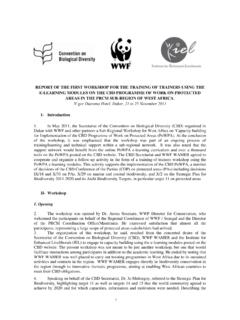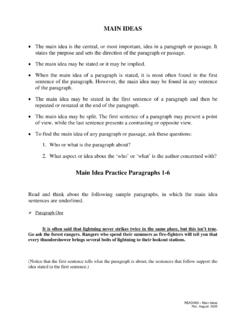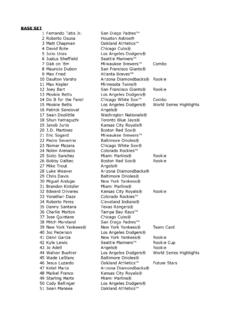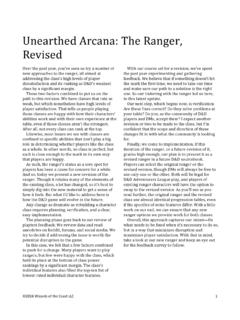Transcription of TG 1-97FINAL.qxd 8/3/2004 1:38 PM Page 84 ... - Earth Rangers
1 TG 8/3/2004 1:38 PM Page 84. How Big is My Ecological Footprint? Measuring their dependence on nature on a typical day can give students a new understanding of the connection between personal lifestyle choices and the health of the planet by Tim Turner Subject areas: mathematics, science, social studies Key concepts: ecological footprint, lifestyle, sustainability Skills: lifestyle analysis, critical thinking Location: indoors Time: 1 hour Materials: chart paper, colored markers (blue, green, brown, and black), copy of Personal Eco-Footprint Calculator for each student Tim Turner ach of us consumes some E of the Earth 's products and services every day. How much we take depends on the ways Students calculating their ecological footprints at the Sea to Sky Outdoor School in British Columbia.
2 In which we satisfy our needs and wants the many habits that Having students calculate their ecological footprint together create our lifestyle. We can ask ourselves these gives them a concrete understanding of their own per- questions to get a better sense of what these habits are: sonal impact on the Earth 's systems and offers a means How much water do I use on a typical day? What do I of assessing the sustainability of their lifestyles. More eat and how much do I eat? How much food do I than that, engaging students in an ecological footprint waste? How do I transport myself and how far do I go? analysis elicits curiosity, enthusiasm, and genuine interest How much clothing and footwear do I have and how in taking action to reduce the demand they place on often do I replace it?
3 What and how much stuff do I nature. Students like the fact that the analysis focuses on buy? How much energy and materials are required to their own lives, and they understand its clear message: keep me dry and warm/cool? How much garbage do I that their choices and hence they, themselves can produce? How much land and energy is used for my make a difference. Calculating one's ecological footprint recreational activities? reinforces the notion that sustainability is a journey and Our answers to these questions reflect the demand not a destination and that it is participatory, not a spec- that each of us places on nature. In the 1990s, sustain- tator sport. It serves as a simple guide to living, working, ability gurus Mathis Wackernagel and Bill Rees coined and playing in ways that don't cost the Earth .
4 The term ecological footprint to refer to the load or demand that we place on the Earth 's resources. An eco- How much Earth do we have? logical footprint is a measure of how much of the Our living Earth has a surface area of 51 billion Earth 's biologically productive land and water is needed hectares, but less than one quarter of this under 12. to produce our food, material goods, and energy, and to billion hectares is biologically productive for human absorb our waste. use. This is the amount of land available on the planet to 84 Teaching Green: The Middle Years TG 8/3/2004 1:38 PM Page 85. provide all of the food, water, and other materials that fertility in lakes and oceans. These include the we need to support ourselves. To help students visualize destruction of coral reefs, oil spills, overfishing this, create a pie graph that shows how the Earth 's (of both marine and lake species), and shoreline surface area is divided.
5 Development. 1. Begin by drawing a large circle on chart paper. 7. This leaves a pie chart featuring four segments of Explain that the circle represents the surface area varying sizes an excellent picture of our living . of the Earth . planet. Label the sections, noting the percentage of 2. Draw lines to divide the pie into land and water: 28 the Earth 's surface that each represents and listing percent of the Earth 's surface is land and 72 percent the forces represented by the tentacles.. is water. Wrap-up: Remind students that only the green and blue 3. Focusing on the 28 percent of the pie that is land: sections about 23 percent of the Earth 's surface . color about two-thirds of the land area green to are biologically productive. This small percentage of land represent the 19 percent of Earth 's surface that and water is all we have to produce all of our food, is biologically productive for human use ( , materials, and energy, and to absorb our waste.)
6 These land that is fertile precious slices of the enough to support Earth 's surface are also agriculture, forests, Three Facts and needed by the other 10. or animal life). One Inescapable Conclusion! million or more species color the other third Fact #1: Of the 51 billion hectares of the Earth 's surface, with whom we share the of the land area only 12 billion hectares are biologically productive and planet. brown to represent therefore capable of providing resources and treating the 9 percent of waste. That's 10 billion hectares of land and 2 billion Calculating Earth 's surface that hectares of water. a footprint is marginally produc- tive or unproductive Fact #2: The human population is billion and climb- Have students complete for human use ( , ing. Of the biologically productive land and water that is the Personal Eco- available, our average Earth share is hectares per per- Footprint Calculator to land that is paved, son (not including the needs of all other life forms).
7 As estimate how much of covered by ice, lacks our population grows, we must either reduce our average the Earth 's biologically water, or has unsuit- Earth share or find more Earths to inhabit. productive land and able soil conditions). Fact #3: The amount of biologically productive land on water is needed to sup- 4. Explain that processes port their own lifestyles. Earth is in decline owing to urbanization, overgrazing by such as desertification, The calculator is divided livestock, deforestation, toxic contamination, poor agricul- soil erosion, and tural practices, desertification, and global climate change. into eight categories that urbanization are represent the many ways constantly reducing Inescapable conclusion: Less is more: we all need to that we consume . the amount of biologi- shrink our ecological footprint.
8 Nature each day. Explain cally productive land to students that it is not on Earth . To show a scientific survey, but it this, draw small brown tentacles reaching from the does give a good approximation of the impact of one's border of the brown segment into the green segment. lifestyle on a typical day. More detailed lifestyle analyses 5. Now, focusing on the water realm: include other considerations that usually increase the size color about one-twentieth of the water section of one's ecological footprint. Therefore, the calculation blue to show that 4 percent of the Earth 's derived from this calculator should be seen as a simplifi- surface is lakes and oceans that are biologically cation and an underestimate of reality. productive for human use ( , yield more than Students may point out that some lifestyle choices, 95 percent of the global fish catch).
9 Such as the size of their house or the number of family cars, are not under their direct control. Explain that the color the remaining section black to show that calculator is meant to provide a snapshot of their lives at 68 percent of the Earth 's surface is ocean that present, and that the baseline information they gather will is marginally productive or unproductive for help them to monitor the impact of changes they make human use ( , yields only about 5 percent of in their lifestyles. They may, for example, make different the global fish catch). choices if they purchase their own house or car in the 6. Draw black tentacles from the unproductive-water future . The connection between these lifestyle considera- segment to the productive-water segment tions and their future ecological footprints is an important to represent processes that contribute to loss of learning outcome of using the Footprint Calculator.
10 Living Sustainably 85. TG 8/3/2004 1:38 PM Page 86. Personal Eco-Footprint Calculator Procedure: Complete each of the charts for a typical day in your home community. Add the points on each chart to obtain a subtotal for that category, and transfer it to the summary chart. Use the grand total to calculate your ecological footprint. Water Use My Score Transportation My Score 1. My shower (or bath) on a typical day is: _____ 1. On a typical day, I travel by: _____. No shower / no bath (0) Foot (0). 1 2 minutes long / one-fourth full tub (50) Bike (5 per use). 3 6 minutes long / half full tub (70) Public transit (30 per use). 10 or more minutes long / full tub (90) Private vehicle (200 per use). 2. I flush the toilet: _____ 2. Our vehicle's fuel efficiency is ____ liters/100 kilometers Every time I use it (40) (gallons/60 miles).






